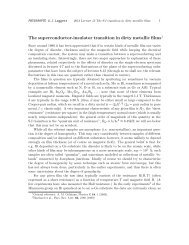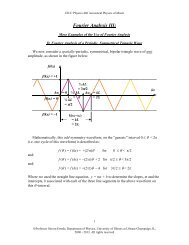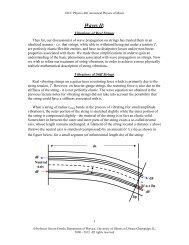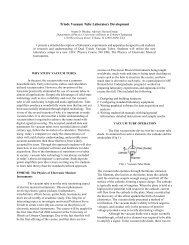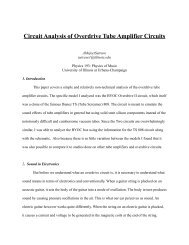1 Quantizing in Curvilinear Coordinates
1 Quantizing in Curvilinear Coordinates
1 Quantizing in Curvilinear Coordinates
You also want an ePaper? Increase the reach of your titles
YUMPU automatically turns print PDFs into web optimized ePapers that Google loves.
Operators We expect there to be operators R, Pr, Φ, Pϕ. If we follow the procedure<br />
used <strong>in</strong> Cartesian coord<strong>in</strong>ates, we would write commutation rules,<br />
These are satisfied if<br />
and<br />
[R, Pr] = i¯h, [Φ, Pϕ] = i¯h<br />
< r, ϕ|Pr|Ψ >= ¯h ∂<br />
< r, ϕ|Ψ >,<br />
i ∂r<br />
< r, ϕ|Pϕ|Ψ >= ¯h ∂<br />
< r, ϕ|Ψ >,<br />
i ∂ϕ<br />
We may now ask if Pr and Pϕ def<strong>in</strong>ed this way are self-adjo<strong>in</strong>t. It will turn out that Pϕ<br />
is self-adjo<strong>in</strong>t but Pr is not. Let us consider Pϕ first. If Pϕ is self-adjo<strong>in</strong>t, we must have<br />
< Ψ2|PϕΨ1 >=< PϕΨ2|Ψ1 ><br />
Def<strong>in</strong><strong>in</strong>g the right hand side as (a), and the left hand side as (b), we have<br />
and (b) is<br />
∫<br />
(a) =<br />
∫<br />
(b) =<br />
Ψ ∗ 2(r, ϕ)( ¯h<br />
i<br />
( ¯h<br />
i<br />
∂<br />
∂ϕ Ψ1(r, ϕ))rdrdϕ,<br />
∂<br />
∂ϕ Ψ2(r, ϕ)) ∗ Ψ1(r, ϕ)rdrdϕ<br />
Show<strong>in</strong>g that (a) = (b) is a simple exercise <strong>in</strong> <strong>in</strong>tegration by parts on ϕ, us<strong>in</strong>g the physical<br />
requirement that wave functions must be periodic, i.e. Ψ(r, 0) = Ψ(r, 2π). So we have<br />
that<br />
Pϕ = (Pϕ) † ,<br />
so quantiz<strong>in</strong>g naively was f<strong>in</strong>e for Pϕ.<br />
Let us turn to ask<strong>in</strong>g the same question for Pr. If Pr is self-adjo<strong>in</strong>t, we will have<br />
< Ψ2|PrΨ1 >=< PrΨ2|Ψ1 ><br />
Aga<strong>in</strong> writ<strong>in</strong>g left and right hand sides out, we def<strong>in</strong>e<br />
∫<br />
(a) =< Ψ2|PrΨ1 >=<br />
Ψ ∗ 2(r, ϕ)( ¯h<br />
i<br />
∂<br />
∂r Ψ1(r, ϕ))rdrdϕ,<br />
and<br />
∫<br />
(b) =< PrΨ2|Ψ1 >= ( ¯h ∂<br />
i ∂r Ψ2(r, ϕ)) ∗ Ψ1(r, ϕ)rdrdϕ<br />
We can get the relation between (a) and (b) by <strong>in</strong>tegration by parts <strong>in</strong> r. Do<strong>in</strong>g so on<br />
(a), we have<br />
∫<br />
(a) = ( ¯h ∂<br />
i ∂r rΨ2(r, ϕ)) ∗ Ψ1(r, ϕ)drdϕ



